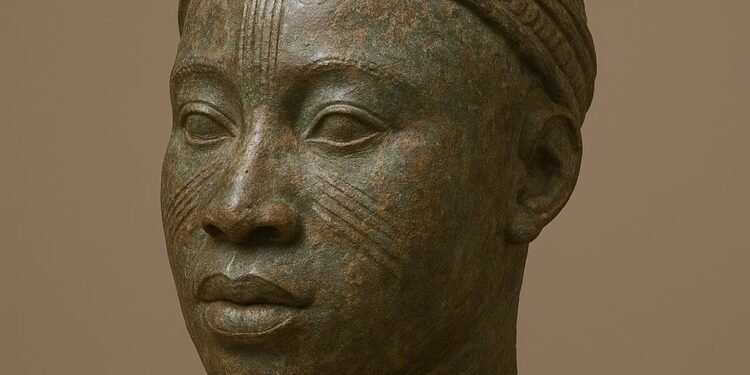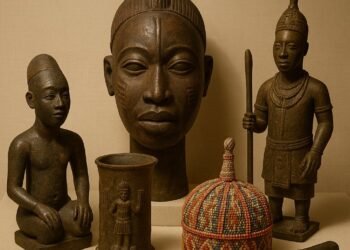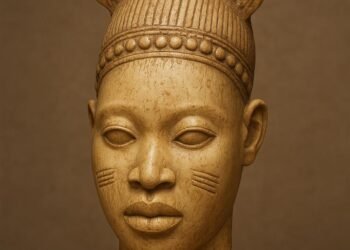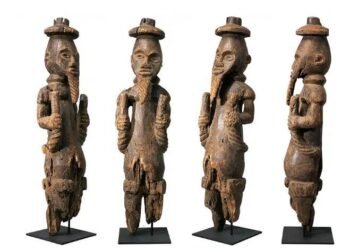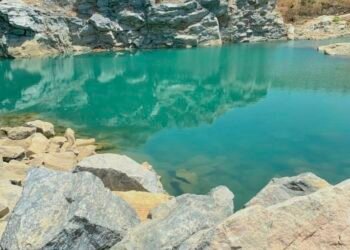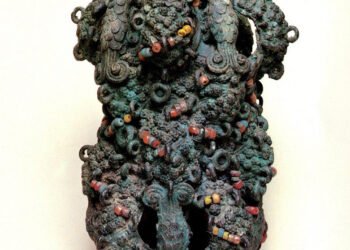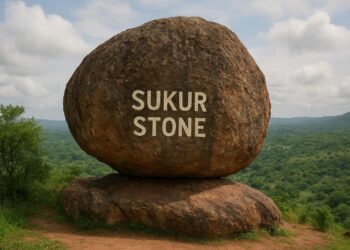Secrets Behind Orangun Ijaye Bronze Head Found
The Orangun Ijaye Bronze Head is a beautiful work of art by the Yoruba, reflecting the region’s rich artistic heritage prior to European contact in West Africa’s pre-colonial era.
This metal head, which comes from a great ancient empire, is the most naturalistic of all traditions. It prompted the world to rethink its definition of African art because it revealed a tradition of technical mastery and intense religious feeling.
Constructed of metal, the head is much more symbolic than functional. It is a bold symbol of royal and cultural heritage, in one unit, bearing a common heritage.
Though greater than a relic of history, its presence is a testament to the immense wit and genius of those who constructed it.
That enigmatic smile remains a source of intrigue for researchers, who continue to debate both its origin and purpose. The artifact remains a source of enduring mystery, inspiring ongoing interpretation and debate.
Table of Contents
Origins and Discovery
The history of the Orangun Ijaye Bronze Head dates back to the artistic hub of ancient Yoruba.
Even though its actual dig is not recorded with equal attention to detail as the celebrated Ife finds, its style immediately situates it within that sacred tradition. It was made within the same world of great craftsmen and courtly sponsorship.
Read Also: What the Owo Mask Reveals About Yoruba History
This piece of work is linked to Ijaye town, which was governed by the Orangun of Ila in ancient times, a king of one of the very old dynasties established at the beginning of the Yoruba kingdoms. This connection solidly positions the bronze head within the realm of court art, made for a great king.
These statues were anything but mere decorations. They were ordered by kings as potent symbols of authority, employing their presence to uphold claims of God’s favor and entrench political power. Simply existing, they served as an ongoing reminder of the ruling house’s dominance and its self-asserted divine favors.
Its discovery, although less well-documented, was no less significant, providing another crucial piece in the jigsaw of Nigeria’s rich cultural inheritance.
A Study in Artistic Perfection
At first glance, the spectator is immediately struck by the realism and dignity of the sculpture.
The head is almost three-quarters life-sized, carved with fantastic attention to the details of the human form. The oval face has almond-shaped eyes that show a thoughtful, wise quality. The lips are full and well-defined, slightly open as if about to say something.
The ears are naturally carved, often detailed with designs that depict the wearing of ceremonial adornments.
This remarkable naturalism was a radical art style in sub-Saharan Africa, centuries before the Renaissance in Europe, and it had a unique artistic trajectory.
The Meaning Behind the Marks
The Orangun Ijaye Bronze Head features a face marked by minute vertical lines, which immediately draw attention.
Not random scratches but deliberate patterns of scarification, called ila in Yoruba life. Far from mere decoration, these lines were a powerful visual language.
They told a story of identity, revealing a person’s lineage, social standing, and deep cultural roots. The flawless precision of these marks carved into metal showcases the artist’s extraordinary technical skill.
Some scholars believe these specific patterns may link the depicted ruler to a particular royal dynasty. Other interpretations suggest a deeper, spiritual meaning, connecting the individual to Yoruba myths of creation.
These striations transform the sculpture from a mere portrait into a complex document of history and belief, written in a language of art.
A Symbolism of a Royal Crown
The elaborate crown resting on the Orangun Ijaye Bronze Head at once signifies royalty status for the subject. It is not a decoration but a complex symbol of authority and identity.
Constructed of detailed tassels, beads, and symbolic depictions, the headpiece would indeed have been a symbolic representation of the actual crowns worn by Yoruba kings.
Read Also: The Fascinating Origins of Oron Kingdom
Scientific examination reveals residues of the original red and black pigments, confirming that the sculpture was originally greatly embellished with brightly colored figures, which further enhances its realistic and dramatic appearance.
The crown turns the work into a political statement. It connects the individual king to the unending institution of kingship and consecrates the concept of ase, divine power and authority to make things happen.
With this breathtaking headdress, the artist conveyed not only the face of a person but also the very essence of their divine right to rule.
An Ancient Engineering Achievement
The manufacture of the Orangun Ijaye Bronze Head is a stunning technical work of excellence. Skilled craftsmen used the lost-wax method, starting with a clay head mold. They carefully cut fine details into a wax layer on top of this core.
There was a second clay mold that held this wax model prior to firing, which incinerated the wax and left a hollow shell. They poured this with molten metal: a characteristic copper alloy unique to Yoruba metallurgy.
What is striking about this achievement is the hard stuff itself. There were some similar sculptures cast in nearly pure copper, a highly hard metal to handle due to its high melting point and viscosity.
This technological skill demonstrates advanced metallurgy brainpower that existed decades ago, an indication of their scientific and creative prowess.
Its Sacred Role in Ritual
The true intent behind the Orangun Ijaye Bronze Head remains somewhat lost in history, although historians have built likely theories.
Most of the evidence suggests that these remarkable sculptures were commissioned for religious rather than public purposes. They would have occupied positions on royal ancestral worship altars.
Here, the bronze head would have been a fine ritual object, a receptacle for the spirit of the deceased ruler. During special ceremonies, it would have been ritually cleansed, adorned with precious materials, and provided with food and drink.
This ceremony established a physical connection between the two worlds, i.e., the world of the living and the world of the dead. This bronze statue was believed to continue guiding and blessing the kingdom, ensuring stability and prosperity for all with the wisdom and defensive power of the ancient kings.
Secrets of the Orangun Ijaye Bronze Head That Remain
Despite extensive research, the Orangun Ijaye Bronze Head guards its mysteries closely. Scholars still cannot identify the specific king it represents, though his importance is undeniable.
The reason for burying this and other Ife-style heads in this way remains unclear. Some think they were hidden during times of war to prevent them from thieves or destruction.
Some believe they were buried as part of a complex royal burial practice, possibly to be used by a king in the afterlife.
Another fascinating question is why some bronze heads possess complex facial striations, while others are completely smooth.
This inconsistency suggests an advanced representational system that has not yet been fully decoded by modern audiences. Each unasked question adds to the enigma of the piece, reminding us that the agendas of ancient cultures were frequently based on ideas with which we are still struggling to keep pace.
A Symbol In The Modern World
The Orangun Ijaye Bronze Head is also rich in greater meaning beyond museum exhibition. It is a Yoruba cultural and historic symbol of great importance, indeed, to all Nigerians.
This statue brings together the modern world with the wonderful works of ancient individuals, creating a living link to a wealth of the past.
It is intriguing to note that the statue provoked worldwide argument about ownership of whom art and what museums have to do. Most items like these were obtained during colonial periods in ways that today seem unfair.
When artifacts are discovered in Western museums, immediate questions arise regarding rightful ownership. The bronze head, for instance, is indicative of a broader repatriation drive to reclaim cultural objects to their home environment.
Read Also: Discover the Beauty of Bwari Rock in Abuja, Nigeria
It is not merely an exercise of logistics; it is the ongoing struggle for cultural dignity, allowing nations and peoples to assume stewardship over their own culture.
A Legacy That Lasts
The Orangun Ijaye Bronze Head ends the sameness of being a silent object. It is an active connection, in motion, that bridges our era to an elegant past.
This painting eloquently bears witness to a civilization that had mastered metallurgy, appreciated beauty in art, and acquired rich spiritual understanding. Its lofty stature still respectfully defies simplistic histories, calling for a deeper appreciation of Africa’s sophisticated heritage.
As an artwork, it is worthy of standing alongside the world’s most honored sculptures. As a cultural symbol, it contains the enduring spirit, philosophy, and grandeur of the Yoruba people.
This bronze head ensures the work of its creators, those visionary artists and kings they immortalized, remains colorfully alive, inspiring and educating generations everywhere in the world.
